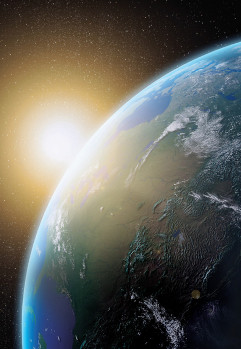NEO NOW EVADE OBLIVION
An unexpected impact from an asteroid or Near-Earth Object (NEO) poses a genuine risk to the planet and the human race. With meteor strikes and asteroid near misses recorded in recent years, space agencies around the world are finally taking the threat of global annihilation more seriously
If the human race doesn’t cause its own extinction through insufficient action on climate change, or via disastrous warfare decisions made by impetuous world leaders, or from creating self-replicating nanobots hell bent on destroying their masters, there’s still a remote yet plausible chance that an asteroid collision will be the end of us. Think uncontrollable firestorms, giant tsunamis and, because the sun would be obscured by debris and rock dust, a prolonged and devastating impact winter.
In Stephen Hawking’s final book Brief Answers to the Big Questions, he wrote that an asteroid collision was likely the biggest threat to the planet and our survival on it. But when it comes to notions of Armageddon, asteroids have been somewhat overlooked. The likelihood of a cataclysmic impact seems so slim that no substantial pre-emptive or emergency response programme exists yet.
In a 1996 report for the US Air Force entitled Planetary Defence: Catastrophic Health Insurance for Planet Earth, the authors stated: “Most of the world’s population does not know or care about the prospect of cosmic collisions, although this hazard from space is a subject of deadly concern to humanity.”
It seems there is plenty to worry about on Earth already, without adding potential obliteration thanks to an asteroid heading directly for it, so most people pay this possibility no heed. The authors of the report go on to say: “When we learned that our team had been assigned the topic of ‘Planetary Defence’ we admittedly did what most people do when they first consider the subject: we laughed. However, once we immersed ourselves in the data and began to work directly with several of the growing number of astronomers and scientists actively working t his p roblem, o ur l aughs w ere q uickly replaced with concern.
“Our concern was based not only on the prospects of the Earth being confronted with the crisis of an impending impact of a large asteroid or comet but the fact that such impacts occur far more frequently than most people realise, and that the global community, although becoming increasingly serious about this threat, currently lacks the capability to adequately detect or mitigate these extra-terrestrial objects. More importantly, however, is the fact that the impact of a relatively small asteroid would, in all likelihood, cause catastrophic damage and loss of life – even the possible extinction of the human race!”
The evidence of major asteroid impacts is v isible around the world. The Vredefort Crater in Free State, South Africa, which in 2005 was awarded UNESCO World Heritage Site status, is the world’s largest known asteroid impact structure, with a radius of 190 kilometres. Scientists estimate the impact date to be two billion years ago. In Ontario, Canada, there is the Sudbury Basin, created around 1.8 billion years ago, which has a diameter of 130 kilometres.
In a 1996 report for the US Air
Force entitled Planetary Defence:
Catastrophic Health Insurance
for Planet Earth, the authors
stated: “Most of the world’s
population does not know or
care about the prospect of cosmic
collisions, although this hazard
from space is a subject of deadly
concern to humanity”
In more recent terms, it was 66 million years since a 10-kilometre-wide asteroid collided with Earth and caused the Cretaceous–Paleogene event, otherwise known as the main cause for the extinction of the dinosaurs.
Despite the inconceivable amount of time passed, it doesn’t mean a similar event won’t happen again. It could also mean that another strike is overdue. According to the B612 Foundation, a private nonprofit foundation based in California and dedicated to planetary defence against asteroids: “It's 100 per cent certain we’ll be hit [by a devastating asteroid], but we’re not 100 per cent sure when.”
Certainly collisions of Near-Earth Objects (NEOs) and meteors, which are not solid lumps of leftover materials from the solar system’s formation like asteroids, but smaller collections of rocks and space particles, have occurred in more recent times. In 2013, the Chelyabinsk meteor burst brightly over the skies of central Russia, and subsequently on screens worldwide, as it entered the Earth’s atmosphere and crashed into the city. Amazingly there were no fatalities, but approximately 1,500 people were injured, mainly from broken glass as the explosion’s shock wave damaged 7,200 buildings in six cities across the region.
Weighing around 13,000 metric tonnes (more than the Eiffel Tower), and measuring about 20 metres in diameter, it is the largest known natural object to have entered the atmosphere since 1908, when a meteor fireball exploded over a remote forested area in Siberia near the Stony Tunguska River. Known as the Tunguska Event, it is estimated that this explosion would have wiped out an entire metropolitan area, but as it landed in an unpopulated area of forest, no deaths were recorded. The explosion was estimated at 15-megaton, which represents energy of about 1,000 times greater than that of the atomic bomb dropped on Hiroshima, Japan. It destroyed around 80 million trees over an area of 2,150 km2 and it triggered seri-ous talks about asteroid impact avoidance.
The discussions have evolved over the last 111 years, especially since the National Aeronautics and Space Administration (NASA) has listed 73 asteroids that have a one in 1,600 chance of hitting the Earth, yet no actionable and reliable Planetary Defence System (PDS) exists yet.
In the same year as the Chelyabinsk meteor, experts testified to the United States Congress that NASA would require at least five years of prepara-tion before a mission to intercept an asteroid could be launched. On October 12, 2017, an asteroid named 2012 TC4, measuring 15 – 30 metres in diameter and travelling through space at around 25,000 kph, came within 43,000 kilometres of Antarctica. While that may sound far enough away to not cause concern, in planetary terms it is more like a close shave.
As well as alarm bells set ringing from TC4, NASA has also been monitoring an asteroid called Bennu, which can be seen every six years from Earth, and which is expected to pass between our planet and the Moon in 2135.
In a substantive step towards more adequate prep-aration for asteroid and NEO events, the space agency is developing project HAMMER in a joint venture with the US National Security Administration and a weapons lab from the US Energy Department.
HAMMER stands for Hypervelocity Asteroid Mitigation Mission for Emergency Response, and is effectively a nearly nine-tonne spaceship that would fly directly into a threatening asteroid to deflect its course away from Earth. A secondary and more con-clusive option is to load the ship with a nuclear bomb to detonate the asteroid in space – an option that is also being explored by Russian scientists.
“If the asteroid is small enough, and we detect it early enough, we can do it with the impactor. The impactor is not as flexible as the nuclear option though, when we really want to change the speed of the body in a hurry”
DAVID DEARBORN, ASTROPHYSICIST
In a paper published in the Journal of Experi-mental and Theoretical Physics, the Russian team of scientists described how they replicated the destruction of an asteroid on a tiny scale by firing a laser beam at a model asteroid measuring just 4mm long and requiring 200 joules of energy to destroy it. Comprised of researchers from the Moscow Institute of Physics and Technology, the Russian Federal Nuclear Centre and the nuclear energy company Rosatom, the team estimated that a 3-megaton nuclear weapon would be required to destroy a 200- metre wide asteroid.
Whilst the nuclear method sounds much more drastic than the “kinetic impactor” method, where the asteroid is struck by a spaceship years in advance of the predicted strike to alter its trajectory and clear Earth, it has wide support from all the space agencies involved in this field.
Astrophysicist David Dearborn, a global authority on the subject of Earth-threatening asteroids and a researcher in the USA at Lawrence Livermore National Laboratory (LLNL) since 1983, said: “If the asteroid is small enough, and we detect it early enough, we can do it with the impactor. The impactor is not as flexible as the nuclear option though, when we really want to change the speed of the body in a hurry.”
Dearborn’s work involves the design and testing of both nuclear and conventional explosives and he leads a team that is modelling the impact of a nuclear explosion on an object’s trajectory in space. “Should an emergency arise, we should know that it’s available, and we should have some idea of how to properly use it,” he added. He stands by nuclear deflection as the optimal solution, saying: “It is the only method that works for large bodies (1,000 metres), or if the discovery time is late enough that a small speed change is not enough.”
Well over a century since the Tunguska Event, it is now globally accepted that a Planetary Defence System or PDS is of paramount importance to prevent catastrophic destruction and loss of life and even save the human race from extinction.
The Planetary Defence: Catastrophic Health Insurance for Planet Earth report concluded: “The issue is not if, but when an asteroid or comet will suddenly be detected a s a threat, causing global chaos and panic and ultimately placing all of humanity at risk. The obvious question, then, is: Do today’s leaders possess the same conviction towards preserving the human race, and, are they willing to invest in the PDS as a ‘catastrophic health insurance policy’ for planet Earth?
We are not there yet. In June 2018, the US National Science and Technology Council warned that America is still unprepared for an asteroid impact event, and developed and released the National Near-Earth Object Preparedness Strategy Action Plan to better prepare.
The plan is a comprehensive road map for a collaborative approach to developing effective technologies, policies, practices and procedures for decreasing American and global vulnerability to NEO impacts. The plan concludes that, when implemented it “will improve detection, research, mission planning, emergency preparedness and response, and domestic and international engagement. Implementing the NEO Action Plan will increase the United States’ ability and readiness, together with domestic and international partners, to mitigate the impact hazard posed by NEOs”.








